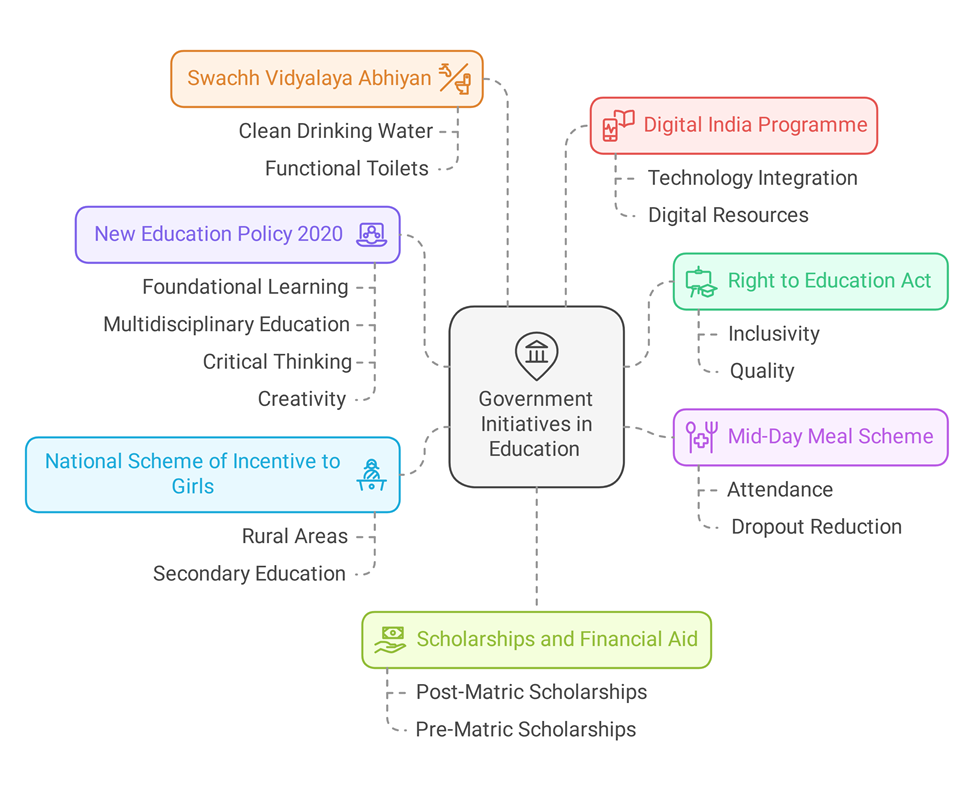Education is the cornerstone of a nation's development, serving as a catalyst for economic growth, social equity, and cultural progress. Over the years, India has made significant strides in enhancing enrollment rates and access to education. However, systemic challenges and recent insights from the Unified District Information System for Education Plus (UDISE+) reports for 2022-23 and 2023-24 underscore persistent issues in the sector. A decline in student enrollment and the closure of schools raise concerns about the effectiveness of the current system and the urgent need for reforms.
Declining Enrollment and Schools: Insights from UDISE+ Reports
Key Findings
1. Student Enrollment Trends:
o Student enrollment declined from 26 crore in 2018-19 to 24.8 crore in 2023-24, reflecting a loss of 1.22 crore students (6%).
o A notable drop of 37 lakh students occurred between 2022-23 and 2023-24.
2. Reduction in Schools:
o The total number of schools reduced from 15,58,903 in 2017-18 to 14,71,891 in 2023-24, a decrease of 87,012 schools.
o Government schools accounted for 76,883 closures, disproportionately affecting access in rural and underserved areas.
3. State-Specific Declines:
o Jammu and Kashmir saw 4,509 fewer schools, followed by Assam (4,229), Uttar Pradesh (2,967), Madhya Pradesh (2,170), and Maharashtra (1,368).
Causes of Decline
- New Data Collection Methodology: The UDISE+ system, introduced in 2022-23, uses Aadhaar-linked individual student data, eliminating duplicate or inflated enrollment figures.
- School Closures and Mergers: The reduction in government schools, often attributed to mergers, has not been accompanied by adequate communication or infrastructure support for affected students.
- Infrastructure and Accessibility Issues: Insufficient facilities and poor management during closures have forced many students, particularly in rural areas, to drop out.
Broader Challenges in India’s Education System
· Inequality in Access: Educational opportunities remain unevenly distributed, with rural areas and marginalized communities facing significant barriers.
o Urban schools are often better equipped, leaving rural students at a disadvantage.
· Quality of Education: Despite high enrollment rates, outdated teaching methods, inadequate teacher training, and limited resources lead to poor learning outcomes.
o The absence of a student-centric approach exacerbates the quality deficit.
· High Dropout Rates: Many students drop out at the secondary level due to financial constraints, early marriage, or a lack of interest driven by uninspiring curricula.
· Infrastructure Deficiencies: A lack of basic facilities, including classrooms, functional toilets, and electricity, severely affects students’ learning environments, particularly in rural schools.
· Focus on Rote Learning: The curriculum continues to prioritize memorization over critical thinking, creativity, and problem-solving skills, limiting students’ holistic development.
· Inadequate Funding: Public spending on education remains below the global average, hindering improvements in infrastructure, teacher training, and technological integration.
· Overburdened Curriculum: The rigid and content-heavy syllabus leaves little room for practical skill development, extracurricular activities, or student well-being.
· Access to Higher Education: The demand for quality higher education far exceeds supply, leading to intense competition and limited opportunities for rural and marginalized students.
· Technological Divide: Limited access to digital tools and internet connectivity in remote areas exacerbates the digital divide, excluding many students from technology-driven learning.
Government Initiatives Addressing Education Challenges
· Right to Education (RTE) Act, 2009: Ensures free and compulsory education for children aged 6-14, focusing on inclusivity and quality.
· Mid-Day Meal Scheme: Provides nutritious meals to students in government schools to enhance attendance and reduce dropout rates.
· National Scheme of Incentive to Girls for Secondary Education: Encourages girls from rural areas to pursue secondary education through financial incentives.
· Swachh Vidyalaya Abhiyan: Aims to improve school sanitation facilities, ensuring clean drinking water and functional toilets, which significantly benefit girls.
· Digital India Programme: Seeks to bridge the digital divide by promoting technology integration in education and providing access to digital resources.
· Scholarships and Financial Aid: Programs such as Post-Matric and Pre-Matric scholarships support economically weaker students, enabling them to continue their education.
· New Education Policy (NEP) 2020:
o Introduces a 5+3+3+4 structure for schooling, emphasizing foundational learning and multidisciplinary education.
o Focuses on critical thinking, creativity, and reducing the reliance on rote learning.
o Promotes holistic development, early childhood care, and flexible pathways for students.
Recommendations for a Stronger Education System
1. Strengthen Infrastructure: Invest in rural schools to meet RTE standards for classrooms, electricity, toilets, and drinking water.
o Establish robust systems to accommodate students affected by school mergers.
2. Improve Teacher Training: Provide continuous professional development opportunities for teachers to adopt modern pedagogical methods.
3. Revise Curriculum and Pedagogy: Shift from rote learning to critical thinking, creativity, and practical problem-solving skills.
o Include vocational training and skill development in school curricula.
4. Bridge the Digital Divide: Expand internet connectivity and digital tools to underserved regions.
o Train teachers and students in the effective use of technology for learning.
5. Enhance Data Transparency and Accountability: Maintain accurate data collection and ensure transparency in resource allocation under schemes like Samagra Shiksha.
6. Engage Communities: Foster greater community involvement in decision-making processes, particularly in addressing dropouts and ensuring girls’ education.
7. Increase Public Spending: Allocate more funds to education to enhance infrastructure, implement reforms, and expand access to quality education.
Conclusion
India’s education system stands at a critical juncture, with the UDISE+ data revealing alarming trends in enrollment and infrastructure. Despite challenges, the government’s proactive initiatives, including the RTE Act, Mid-Day Meal Scheme, and NEP 2020, have laid a foundation for systemic improvement. To build on these efforts, the education system must prioritize equitable access, quality enhancement, and holistic development. Collaboration between policymakers, educators, and communities will be key to transforming the sector into one that empowers every child and fosters national progress. With sustained efforts, India can achieve its vision of an inclusive, equitable, and innovative education system.
| Main question: Examine the role of the New Education Policy (NEP) 2020 in reshaping India’s education system. How does it propose to address the existing challenges related to rote learning and infrastructural deficiencies? |








